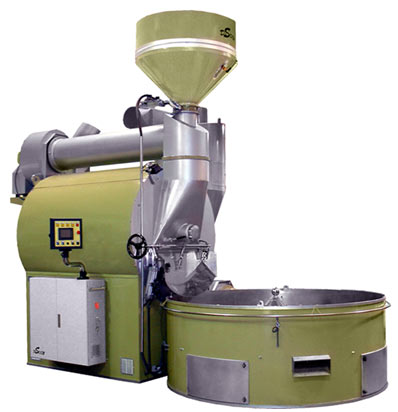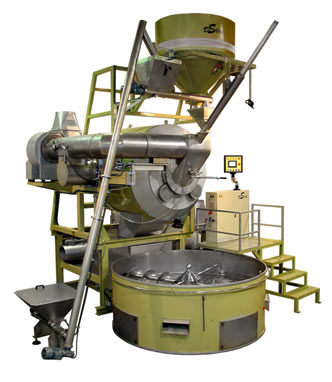The secrets of coffee
Roasting and grinding of coffee
An infusion of green unroasted coffee is undrinkable. It is through the delicate and skillful operation of roasting that coffee shows its secrets. The coffee will vary its look swelling, changing its colour and turning brittle. Fats will increase, sugars and chlorogenic acids will reduce and more than seven hundred aromatic compounds, hidden up to that moment in the bean, will show a wonderful symphony up for our taste and smell. Let’s try to describe clearly the best methods of roasting and grinding coffee industrially.
General principles
The roasting of coffee is a vital phase in its processing chain. Some people think, and not without reason, that good roasting is more important in the quality of a cup of coffee than the goodness of the mix that has been chosen. The process of roasting green coffee beans is to expose them to high temperature for a limited period of time:
It loses weight, (about 15/20%), largely due to the evaporation of its moisture and also due to the pyrolysis of some components.
The bean increases its volume, between 100 and 130% in the case of natural coffee referring to the time of roasting and between 70 and 80% referring to the roasted coffee.
Its greenish-yellow colour becomes a brown one, more or less dark.
Depending on the kind of roasting that was chosen.
The chemical composition of the bean undergoes an important transformation, both at quantitative and qualitative levels. Sugars, fats, proteins, non-proteict nitrogened substances, acids … everything is transformed by the high temperatures to which the beans are exposed.
This last point is the most interesting one from a gastronomic perspective because it is where the aromas and flavours that have turned the coffee in the king of the infusions come from. The main role in this process is the transformation of carbohydrates, fats and acids. And a very important physical feature is the solubility of roasted coffee which is essential to make the infusion.
To obtain the highest quality of each variety of coffee, roasting must be specific to each one of them. There are four types of very differentiated coffee which require specific roasting: natural arabics and washing and natural “robustas” and washing.
Basic variables of roasting coffee
The basic variables in the process of roasting coffee are temperature and time in which it operates. The temperature is not constant but varies throughout the process and the time is inversely proportional to the temperature. It is difficult to give general guidance because several factors are involved:
The technical characteristics of the roasting machine and the industrial installations used and the various technologies used by each manufacturer.
The expected levels of production: it is not the same case for the system used by a medium roaster, who can roast coffee a few hours a day, than the necessary one for a large company which operates full time.
The final product to obtain: roasted beans, instant coffee, freeze-dried …
The taste of each market or type of consumer. The Nordic countries like a less roasted kind of coffee than the Mediterranean ones. Hostels need a different coffee than that used for food; expresso machines require a different type of coffee than domestic ones…
The variety of coffee, since each type requires a proper roasting.
The temperature of roasting
The temperature of roasting depends on the type of the roasting machine, the time of the roasting and the intensity of the final color required.
In the first phase, the moisture of the coffee is dried andi t is the phase which less affects the final taste. In a second phase, the expansion of the cells of the coffee bean begin and the gasses start its formation. The third phase of the roasting must be slower because it is then when the final taste of the product is achieved.
Timing
The time of roasting varies from a minute to a maximun of 25 or up to 30 minutes, depending on the roasting machine:
The slow system.- from 12 to 20 minutes, it is highly appreciated by the skilled roasters (artisans). So they get a bean with a dark and uniform colour, beautiful, with an excellent look to be sold in detail and as a bean. All our machines are based on this system.
The Fast process.- 1 to 3 minutes, there are detractors who affirm that it produces less quality than the previous system. It gets less reduction when roasted which is usually about 2% – and it is mainly used for roasting coffees of lower quality (which are sold abready ground).
Besides, the decision to decide on the timing of toasting of the mixture depends on different things:
The consumption habits of the country where it is going to be sold or consumed.
• The type of machine
The kind of coffee that we are going to toast: more acidic coffees need a longer toasting and a bit darker if we want to stop this acidity so that it will not be so strong. More neutral coffee needs a shorter toasting.
The type of toasting: according to its origin or blend.
The destination of the coffee: hostels or feeding
The roasting for espresso coffee
Everybody knows that preferences depend on each individual, but in general most of these ones point at a dark toasted coffee for each one of the possible varieties that will get the ideal mixture. This means not to roast a mixture and it is a `must` to mix them after the roasting; this remark has lead to extensive and unsolved arguments among professionals.
Arabic varieties will be mostly used but also little quantity of robusta.
In this case the master roaster is the cornerstone trying and testing as many times as necessary to find out the taste and aroma that will be the characteristic of the brand.
Once they decide, modern technologies used in our coffee roasters at the service of the master roasters allow to repeat the process of roasting systematically and to make products of the same characteristics, what helps the work of the little grinder and the coffee machine in the bar, getting a cup of coffee with a unique blend, its own one.
System of roasting
There are two major divisions:
Coffee roasters by load and of coffee roasters by continuous action, depending on either roasting processes chained one to the other, or a unique process continuously fed.
1 – Load or turn roasters
There is a range of machines with toasting capability from 500 grames to 300 kg. Below this heading we can explain the inner work for the roasting of coffee. Our roasting machines always work by the drum system:
Drum system
It is a long process, between 12 and 18 minutes, and coffee is roasted by hot air. The volume of hot air is kept constant or varies according to the characteristics of the roasting machine rising up temperature at regular intervals during the whole process. This air is relatively dry, with a water content from the exhaust of 18 grams per m3.
With this system great uniformity in the roasting of beans is got, not only in the kernel but also on the hull because of the uniform distribution of warm air all over the coffee which is spinning in the drum. This system is the best to roast coffee of different characteristics and allows to get dark toasting.
There is not only one system to show every step to follow during the whole process: every manufacturer and every roaster depending on their experience, their own tastes and the kind of coffee to be processed, give it a personal touch.
So, they vary the temperature rising it step by step always about 200 ºc or they put into ambient temperature air, to open the bean and not to burn it sstopping the combustion or they vapourize the coffee in last phase of the roasting, injecting water in the proportion of 1 litre per 10 kg of coffee.
There are people who are against adding water in this phase because they have checked that doing this the coffee can go rancid. So, they prefer the system of air cooling, that helps to keep aromas and flavors.
All our coffee – roasting machines allow us to choose the different options which we have described, we can vary the level of water which has been injected to please the master roaster and the roasting machine will also make it possible to change the flow of warm/hot air that is circulating in and in contact with the cooffe in an automatic way in the proper moment; the coffee-roast has also got a practical and easy system to store recipes and to adjust the machines in order that it works automatically with each type of coffee.
Most of the “master” roasters are quite satisfied with a roaster of perforated stainless steel drum, which makes it possible the entry of air and processed coffee is better developed.
Each machine has a scorecard with full information about the process, usually automatic, according to a selected program and with the possibility of manual operation. The process is usually controlled by temperature and not by time. It is no longer necessary, as in the past, the “attentive ear” of the master roaster expecting the end of the process when the coffee bean swells and gets roasted, and then it cracks and crackles -what is in jargon known as “the singing” – he had to be attentive because shortly after this, a second “singing” must not catch the coffee into the drum, but outsider in the cooling process.
The cooling is done in a round drum, stirring the coffee with blades at ambient temperature. The base is made of perforated plate and a powerful fan on the bottom takes the air in by suction between the beans.

2 – Roasters machines for roasting coffee
Roasting coffee uses a system of roasting vey similar to the roasting of natural coffee but with some changes due to the need of adding sugar or equivalent product in the middle of the process. The roasters machines are a combination of those of the “drum” type. There are three particular steps in the process:
A. The coffee enters the drum and temperature is put 20/30ºC (bellow roasting temperature).
B. Sugar, sucrose or glucose syrup is added to be mixed and melted around the coffee beans. This step takes about 4 minutes and for four minutes air goes around the outer part of the drum to prevent sugar being carried away to the shell decanter.
C. The last step starts with the caramelization of the sugar around each bean. Now hot air circulates mostly inside the drum and little air circulates around the outer part of the drum by contact. On this step, water can be put into to cool the product.
Once the process is finished, the product is sent to a cooling grid which is similar to that used in the natural roasting but with a special design that, by a system of threshing and removing blades, separates each grain and the coffee results completely loose and unsticky.
3 – Mixed roasting.
All our roasting machines are roasted coffee mixed, and they roast either in the natural way or providing additives.
